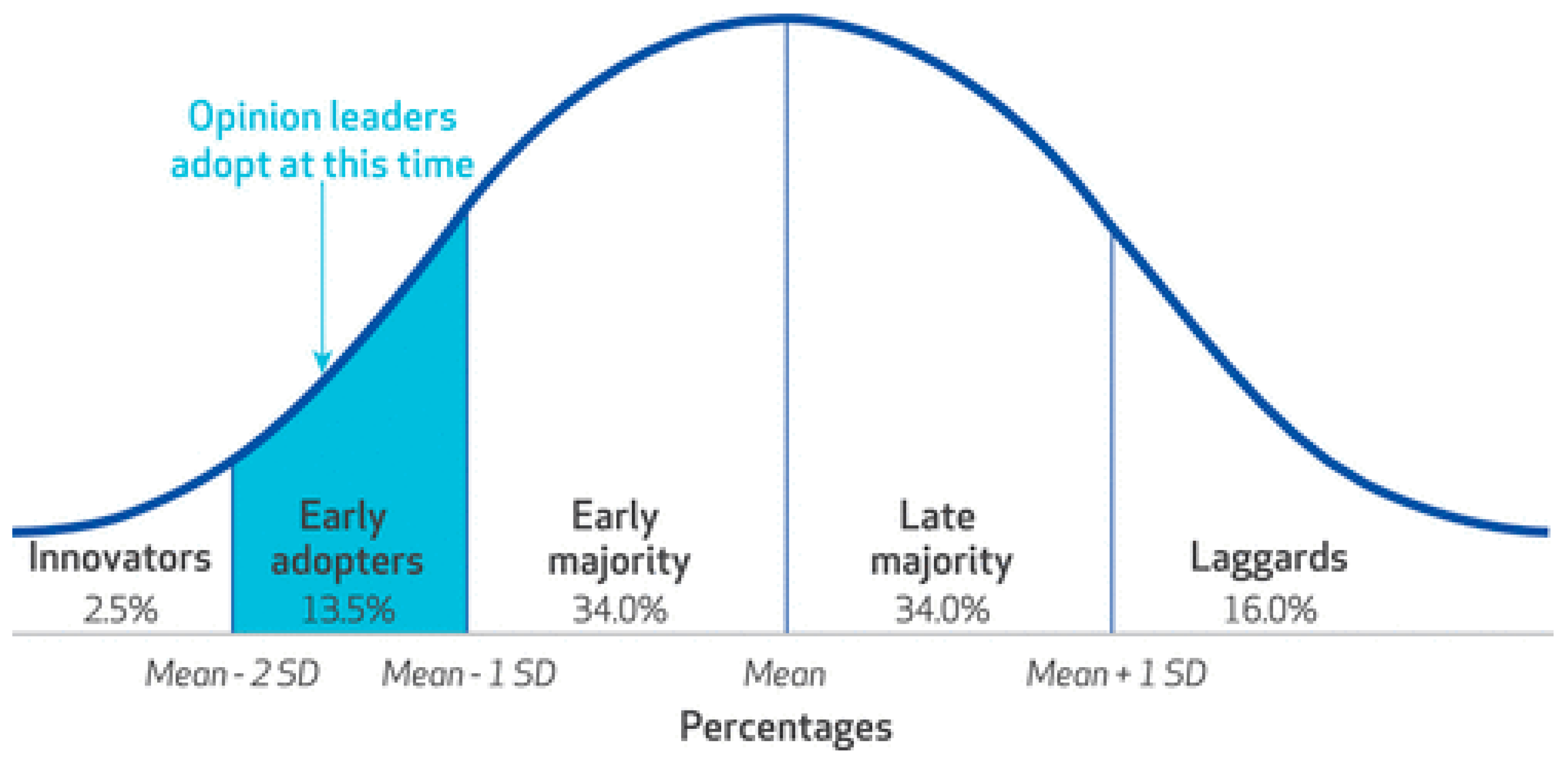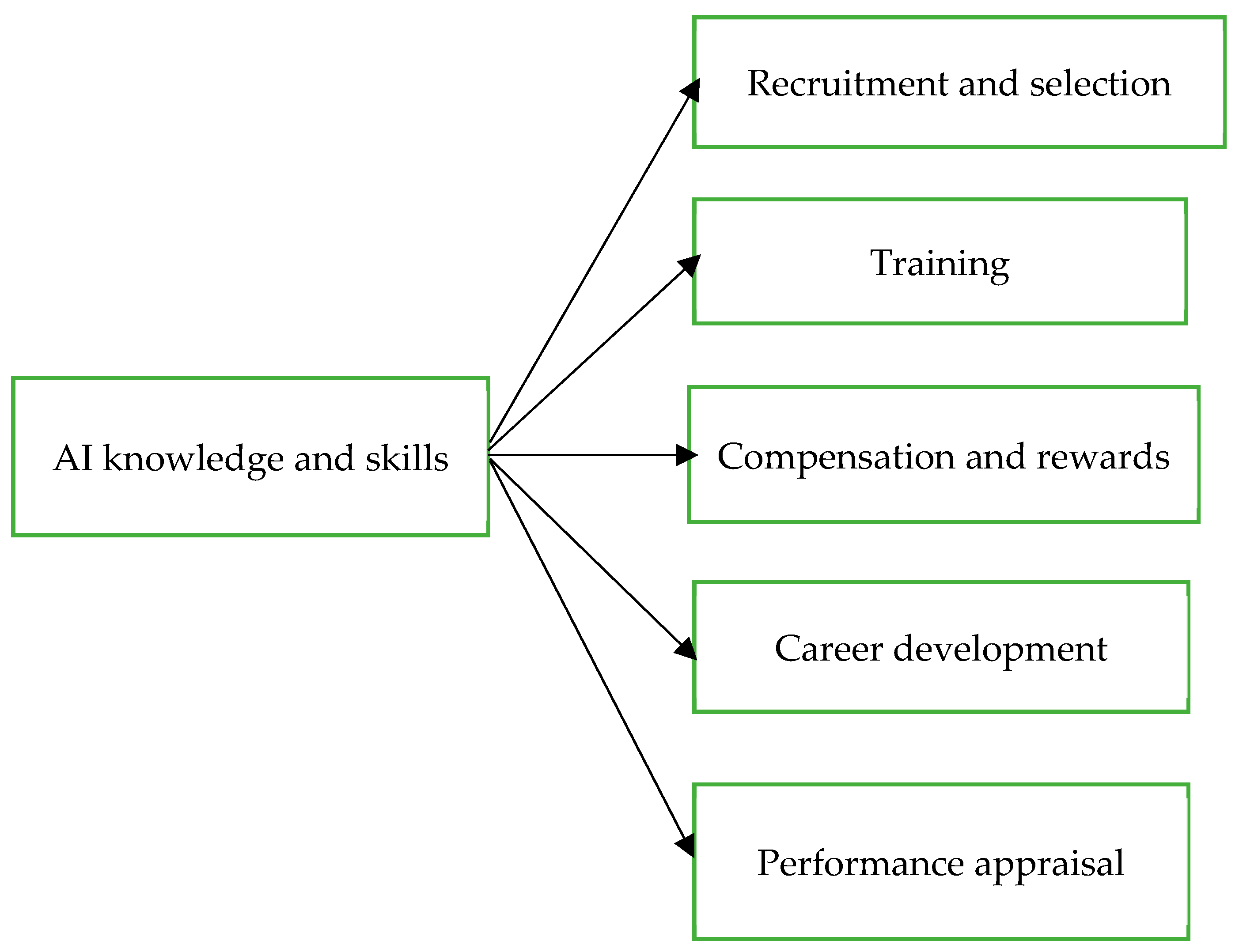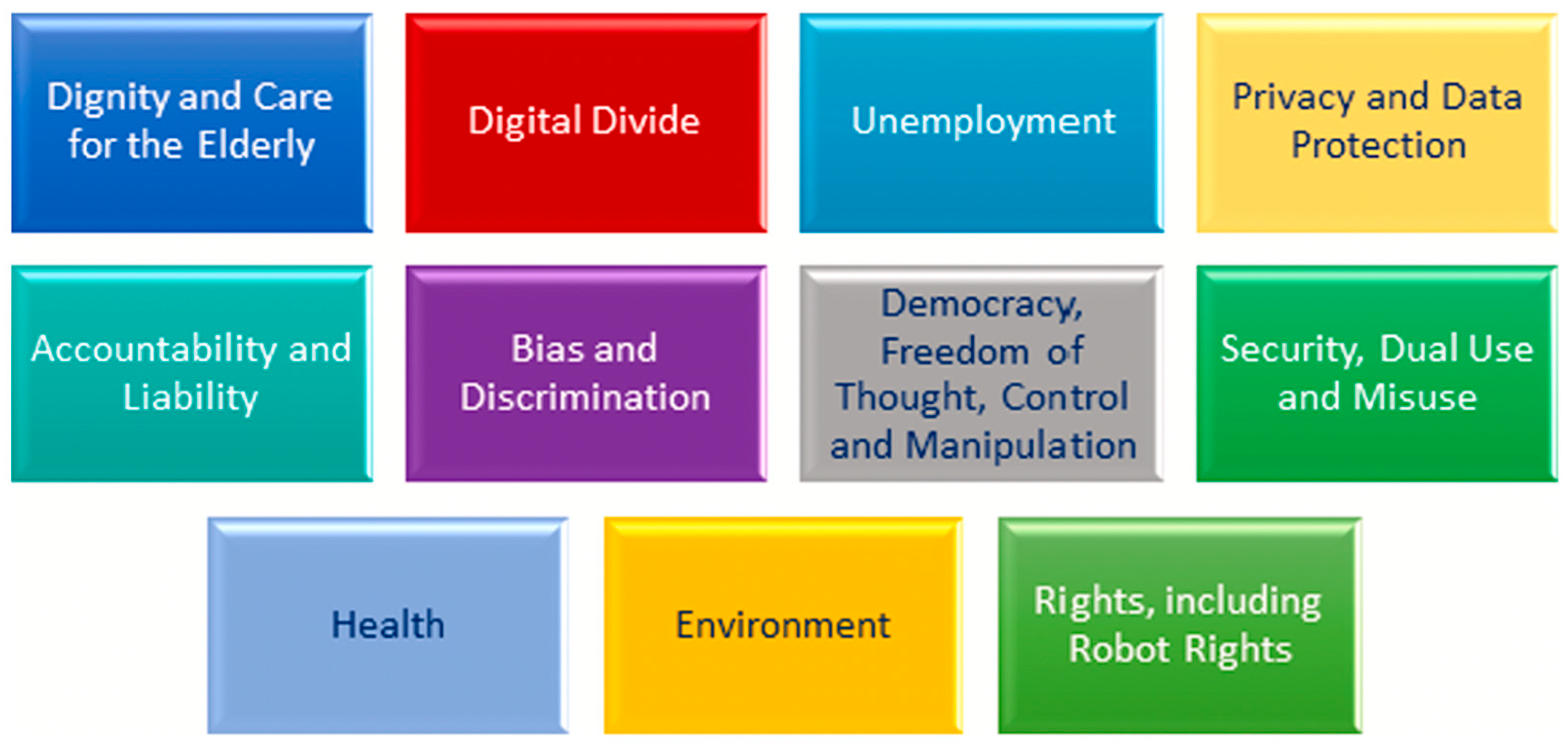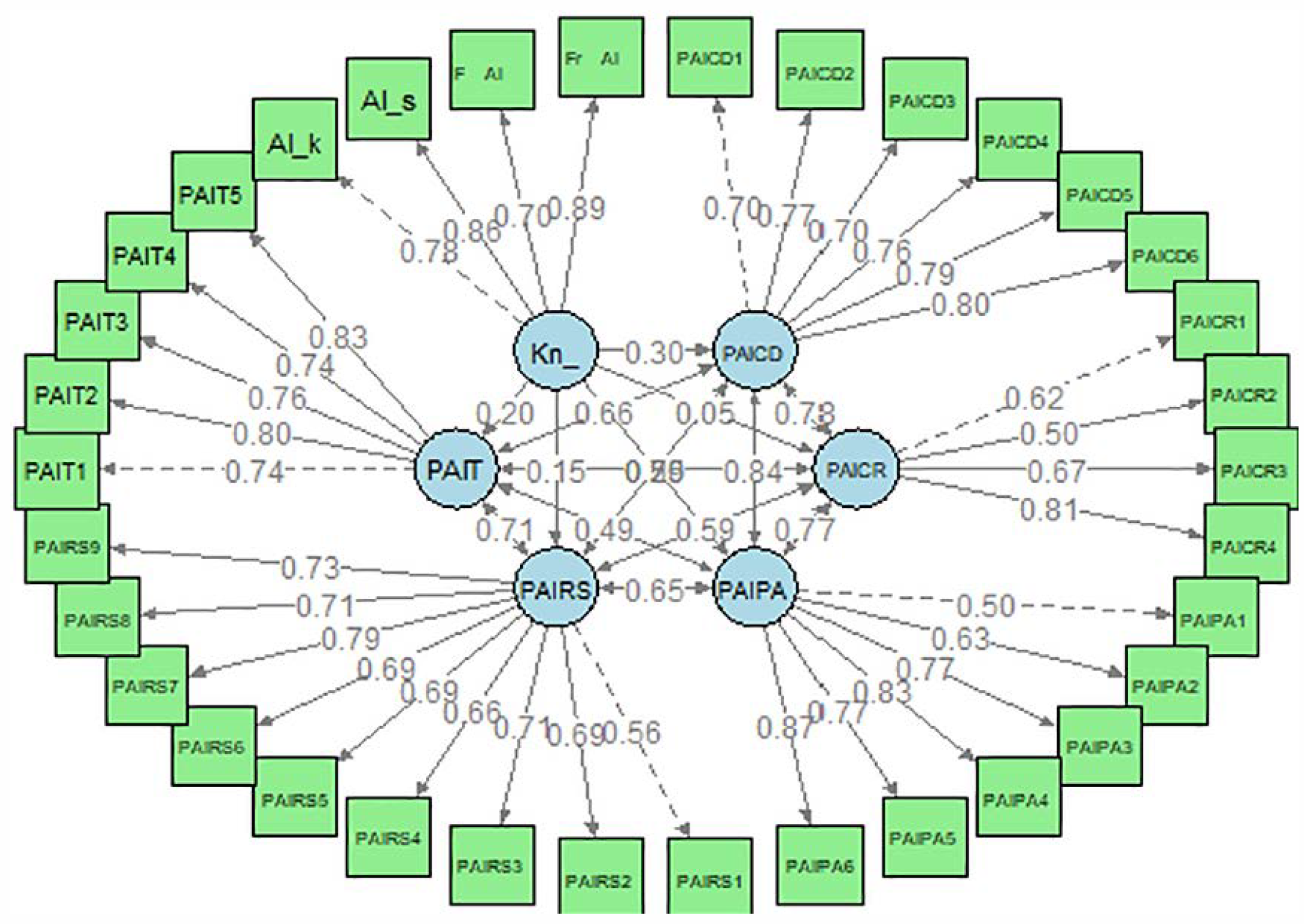1. Introduction
Artificial intelligence (AI), rooted in disciplines such as philosophy, mathematics, computation, psychology, neuroscience, biology, and linguistics, has become indispensable in the services and manufacturing sectors [
1,
2]. AI can be interpreted from various perspectives. Some authors perceive it as an opportunity or a threat [
3,
4,
5], while others see it as a threat and an opportunity [
6]. Specific opportunities in human resource management include predicting workplace hazards, assessing and predicting employee satisfaction, optimizing work scheduling, and forecasting employee turnover [
7,
8].
Threats include job losses, a lack of trust in intelligent technologies among employees and managers, and reduced employee commitment as well as productivity [
9,
10]. Conversely, ref. [
11] argues that AI does not present competition with machines but rather fosters a symbiotic relationship between humans and machines.
Ref. [
6] supports the notion of a symbiotic relationship, arguing that viewing AI as a panacea is shortsighted. Instead, potential partnerships between AI and human resource management should be investigated. Murugesan et al. [
12] observe that, although AI is replacing many tasks traditionally performed by HRM, flexibility remains essential for effective talent management. AI plays a critical role in providing this flexibility and enhancing agility in HRM.
Ref. [
13] defines AI as a field of science and engineering dedicated to developing intelligent systems, comprising software and hardware designed to accomplish specific objectives. Ref. [
14] describes AI as a scientific discipline centered on intelligent behavior, aiming to replicate human capabilities such as thinking, sensing, and reacting. Ref. [
15] characterizes AI as a system’s ability to accurately interpret external data, learn from it, and apply those insights to achieve specific goals. Ref. [
16] defines AI as an engineering technology that processes information by emulating human cognitive activities. AI systems are designed to think and act like humans or to exhibit rational thought and behavior [
15,
17]. These AI technology applications enable managers and employees to streamline or automate complex manual tasks. Ultimately, AI aims to create machines capable of performing tasks traditionally executed by humans. Big data and smart sensors are critical technologies for AI and its successful implementation in human resource management [
18,
19,
20].
In a study on artificial intelligence, ref. [
21] reported that 44% of manufacturing respondents viewed AI as crucial to the “production function”, while 49% deemed it “critical to success”. PricewaterhouseCoopers predicts the potential contribution of AI to reach USD 15.7 trillion by 2030 [
22]. In Saudi Arabia, the government expects AI to generate USD 200 billion in revenue by 2035 [
23].
The impact of AI on human resource management has been explored in multiple studies. Ref. [
24] found that implementing AI in the HRM of a healthcare facility in the UAE required substantial capital investment but yielded competitive advantages. Specifically, AI accelerated the hiring process and facilitated the recruitment of better-qualified staff. Ref. [
25] found that AI adoption in HRM across UAE companies reduced administrative tasks and minimized human bias. However, AI faced challenges such as lack of trust and the absence of a human touch, which are limitations not present in conventional hiring methods. Ref. [
12] found that AI is vital for enhancing employee health and safety, as well as monitoring emotions and truancy, among IT, manufacturing, and services firms in Chennai and Bengaluru. Despite these significant benefits of AI in HRM, some regions continue to lag in its adoption. Ref. [
26] notes that countries in the Global South, encompassing Africa, Asia, Latin America, and the Middle East, lag in AI adoption compared to those in the Global North. Human resource practitioners in Middle Eastern countries such as Jordan, Kuwait, Saudi Arabia, and Qatar exhibit a positive attitude toward implementing AI in human resource management [
27,
28]. Although these Middle Eastern countries have begun adopting AI in HRM, few studies have explored perceptions of HR managers on the impact of AI. Specifically, no study has examined perceptions of HR managers in Saudi Arabia. This research gap inspired the present study. The specific research questions investigated are as follows:
What are the perceptions of HR managers on the impact of AI on human resource management practices?
Are perceptions of HR managers different across age, education, and total working time?
How do knowledge and frequency of AI use influence perceptions of the impact of AI on human resource management practices?
Given the identified research gaps, this study contributes to existing knowledge in three key ways. First, it explores the perceptions of HR managers. Second, it addresses a research gap specific to the context of Saudi Arabia. Third, it enriches the literature by investigating the influence of AI knowledge and frequency of use on perceptions.
This paper is structured as follows:
Section 2 reviews the literature on the main constructs and their interactions to establish a suitable theoretical framework.
Section 3 outlines the research methodology.
Section 4 and
Section 5 presents the results and discussion. Finally,
Section 6 summarizes the study, discusses its implications and limitations, and proposes directions for future research.
4. Results
4.1. Demographic Characteristics
Demographic characteristics of participants are summarized in
Table 2. The sample is predominantly male (79.5%), which may skew perceptions if gender influences opinions on AI in HRM. The low female representation (20.5%) suggests the potential underrepresentation of female perspectives. The 30–34 age group is the largest (32.1%), followed by the 40–44 age group (25.6%). Younger respondents (25–39) dominate (71.7%), suggesting that the sample reflects the perspectives of early- to mid-career professionals, who may be more open to technological changes like AI. Most respondents are university graduates (56.4%) or postgraduates (28.2%), totaling 84.6%. This highly educated sample may have a better understanding or acceptance of AI technologies. Respondents have varied experience, with 6–10 years of total working time being the most common (33.3%). Many are relatively new to their current organizations (0–5 years: 33.3%) and HRM roles (0–5 years: 42.3%), indicating a mix of fresh and seasoned perspectives on AI’s role in HRM.
Table 3 shows a summary of AI knowledge and frequency of use among respondents. Most respondents have average (46.2%) or little (29.5%) AI knowledge, with only 14.2% reporting much or very much. This suggests limited exposure, which can negatively influence optimism about AI in HRM. AI usage is low, with 51.3% reporting very little or little use. This limited engagement may reflect early-stage AI adoption. AI use in HRM is even rarer, with 41.0% reporting very little and only 12.8% using it much or very much. This indicates AI is not yet widely integrated into HRM practices among respondents.
4.2. Perceptions of HR Managers on the Impact of AI on HRM
Descriptive statistics of items in each dimension are summarized in
Table 4,
Table 5,
Table 6,
Table 7 and
Table 8. The criteria developed by [
5] are used to interpret average scores. Compensation and rewards (
M = 3.54), career development (
M = 3.72), recruitment and selection (
M = 3.70), performance appraisal (
M = 3.41), and training (
M = 3.63) had scores between 3.40 and 4.19. This suggests the perception of change towards AI is at a high level.
A correlation heatmap showing interactions between different survey responses is illustrated in
Figure 4. Respondents who believe that AI will help determine fair salaries also strongly agree that AI can reduce human-related delays in payments and ensure the accurate calculation of bonuses and premiums. This suggests that AI is perceived as a tool for improving transparency and reducing biases in salary and compensation management. A strong correlation exists between AI helping employees identify necessary qualifications for their dream careers and assisting in career planning. Those who think that AI will help recognize employees deserving of promotions also believe it will automate wage rises based on skill increases. This indicates that respondents see AI as a career development enabler, helping them to acquire needed skills and opportunities for promotion. Those who think that AI will positively impact corporate culture through performance evaluation also believe that AI will accurately predict future employee performance. A strong link exists between AI ensuring motivation during performance assessments and AI determining fair performance evaluation criteria. This suggests that fair and transparent AI-based evaluation systems could enhance corporate culture and employee satisfaction. Respondents who believe that AI reduces time spent in finding candidates also think that it will increase access to qualified candidates and reduce stress in hiring decisions. Strong correlations exist between AI analyzing resumes in detail and AI selecting the most suitable personnel. These findings suggest that AI is widely perceived as a beneficial recruitment tool, streamlining hiring and improving selection quality. Those who believe AI will make training more accessible also agree that AI will reduce time spent on training and eliminate geographical constraints on learning. AI is perceived as improving learning retention and engagement, reducing attention deficits in traditional training methods.
AI will make training more accessible. Additionally, AI will reduce the time spent on training and eliminate geographical constraints on learning. AI is perceived as improving learning retention and engagement, reducing attention deficits in traditional training methods.
4.3. Differences in Perceptions of the Impact of AI Across Age, Education, and Total Working Time
From
Table 9, it can be observed that the mean of the compensation and rewards (PAICR) dimension is not different across the age and total working time categories. However, the mean is different across the education categories. Post hoc comparison using LSD revealed that the means in the university graduate (
M = 3.43), diploma (
M = 3.42), and high school education (
M = 3.21) categories were similar. However, the mean in the postgraduate (
M = 3.89) category was significantly different. Cohen’s d indicated that differences between the postgraduate and university graduate categories were moderate (es = 0.61), those between the postgraduate and high school education categories were moderate (es = 0.66), and those between the postgraduate and diploma categories were moderate (es = 0.76). These results suggest that participants with postgraduate education had the highest perception of change towards compensation and rewards.
The mean of the career development (PAICD) dimension is not different across the age and education categories. However, the mean is different across the total working time categories. Post hoc comparison showed that all of the categories had significantly different means: 11–15 years (M = 3.92), 6–10 years (M = 3.80), 16–20 years (M = 3.73), more than 21 years (M = 3.55), and 0–5 years (M = 3.37). Cohen’s d indicated that differences between 0–5 years and 11–15 years were moderate (es = 0.7), differences between 0–5 years and 16–20 years were small (es = 0.45), differences between 0–5 years and 6–10 years were moderate (es = 0.56), differences between 11–15 years and 16–20 years were small (es = 0.26), and differences between 11–15 years and more than 21 years were small (es = 0.43). These results suggest managers that worked for the shortest period had the lowest perception of change towards career development.
The mean of the performance appraisal (PAIPA) dimension is not different across the age and education categories. However, the mean is different across the total working time categories. Post hoc comparison using LSD revealed that means in the 16–20 years (M = 3.46) and 6–10 years (M = 3.46) categories were similar. However, the means in the 11–15 years (M = 3.67), more than 21 years (M = 3.26), and 0–5 years (M = 3.00) categories were different. Cohen’s d indicated that differences between the 0–15 years and 11–15 years categories were large (es = 0.83), differences between the 0–5 years and 16–20 years categories were moderate (es = 0.61), differences between the 0–5 years and 6–10 years categories were moderate (es = 0.56), and differences between the 11–15 years and more than 21 years categories were moderate (es = 0.56). These results are similar to those for career development, as managers who had worked for the shortest time had the lowest perception of change. However, the means across the categories in the PAIPA dimension were lower compared to the PAICD dimension. This suggests that participants had a higher perception of change towards performance appraisal compared to career development.
The mean of the recruitment and selection (PAIRS) dimension is not different across the total working time but is different across the age and education categories. Post hoc comparison revealed that the age categories 25–29 (M = 3.87), 50 and above (M = 3.86), and 30–34 (M = 3.75) had similar means. However, the age groups 45–49 (M = 3.61) and 40–44 (M = 3.50) had significantly lower means. Cohen’s d indicated that differences between the 25–29 years and 40–44 years categories were moderate (es = 0.58), while the other pairwise differences were small or negligible. These results generally suggest that older managers have a lower perception of change towards AI. However, the cause of the high perception of change observed among managers aged 50 and above years is not clear. Post hoc comparison of education categories revealed that the mean across all the categories was significantly different for the postgraduate (M = 3.95), university graduate (M = 3.43), diploma (M = 3.42), and high school education (M = 3.21) categories. Cohen’s d indicated that differences between the diploma and postgraduate categories were large (es = 1.32), differences between the diploma and university graduate categories were large (es = 0.94), and differences between the high school education and postgraduate categories were moderate (es = 0.65), while the other pairwise differences were small. These results suggest that there is a trend, with higher education having a higher perception of change compared to a lower category. This is in contrast to compensation and rewards, where the high school education, diploma, and university graduate categories had a similar mean.
The mean of the training (PAIT) dimension is not different across age and total working time, but is different across the education categories. Post hoc comparison revealed that the means across the postgraduate (M = 3.82), university graduate (M = 3.62), high school education (M = 3.40), and diploma (M = 3.20) categories were significantly different. Cohen’s d indicated that differences between the diploma and postgraduate categories were large (es = 0.9), while differences between the diploma and university graduate categories were moderate (es = 0.66), and the other pairwise differences were small. This trend is similar to that observed in recruitment and selection, where participants with higher education had higher perception of change.
4.4. The Influence of Knowledge and Frequency of AI Use on Perceptions of the Impact of AI
Figure 5 illustrates SEM being used to investigate the influence of the knowledge and frequency of AI use. The oval shapes show the latent variables, while the rectangles show the observed indicators. The model is correctly specified, as there is no item connected to more than one latent variable. The single-headed arrows show factor loadings, while double-headed arrows show correlations among latent variables. All standardized factor loadings are higher than 0.5, indicating that each dimension explains more than 25% of the variation in each item [
72]. AI knowledge and skills were weakly correlated with training, career development, and compensation and rewards, but was moderately correlated with performance appraisal. Correlations among HRM constructs were strong.
Construct reliability and convergent validity measures are shown in
Table 10. The Cronbach’s alpha for each dimension was higher than the required threshold of 0.7 [
73]. The composite reliability for each dimension was higher than the required threshold of 0.7 [
74]. Therefore, construct reliability was achieved for each dimension.
The AVE values of the PAICR and PAIRS dimensions were marginally lower than the required threshold of 0.5, but the AVE values of the other dimensions were higher [
75]. Despite the lower AVE values of the PAICR and PAIRS dimensions, the convergent validity of these dimensions was achieved, as composite reliability was higher than 0.6 [
76].
Discriminant validity measures are shown in
Table 11 and
Table 12. Discriminant validity is assessed using the Fornell–Larcker criterion by comparing the square root of the AVE shown in bold in the diagonal with correlations of constructs in rows and columns [
75]. Some Fornell–Larcker criterion values in the same rows and columns were higher than the diagonal value, hence discriminant validity was not entirely established. Specifically, the correlations between the PAICR and PAICD dimensions, as well as the PAIPA and PAICD dimensions, were of concern. However, all HTMT ratios were lower than the required threshold of 0.90 [
77,
78], as shown in
Table 13. In assessing discriminant validity, HTMT is superior and more stringent compared to Fornell–Larcker [
79,
80]. Therefore, discriminant validity was achieved in all dimensions.
The model fit metrics shown in
Table 11 indicate minor concerns with model fit. The RMSEA and SRMR are below the required threshold. However, the CFI and TLI values of 0.87 and 0.89 were marginally lower than the required threshold of 0.90 [
81,
82].
Path coefficients are shown in
Table 14. The coefficient of the path between knowledge and use and the PAICD dimension is positive and statistically significant. This suggests that respondents with higher knowledge and frequency of using AI had a higher perception of change towards career development. Similarly, the coefficients of the paths along the PAIPA, PAIRS, and PAIT dimensions are positive and statistically significant. This suggests that participants with higher knowledge and frequency of using AI had a higher perception of change towards performance appraisal, recruitment and selection, and training. However, the path along the PAICR dimension was not statistically significant. This suggests that the knowledge and frequency of AI use had no influence on the perception of change towards compensation and rewards. Furthermore, the lower mean rating on the PAICR dimension suggests that there are concerns around compensation and rewards.
6. Conclusions
AI has emerged as a critical element in human resource management practices and has been adopted in countries in Global North. However, countries in the Global South are lagging in its adoption, despite the benefits that could be realized. This slow pace of adoption can be attributed to technological factors and perceptions among HR managers. Saudi Arabia is one of the countries lagging in the adoption of AI. Perceptions that could be hindering the adoption of AI in Saudi Arabia have not been investigated. It is this research gap that motivated this study. Data was collected from 234 HR managers. Results showed that HR managers in Saudi companies have a medium level of AI knowledge and a low level of AI usage. AI was perceived positively, particularly in salary management, recruitment, performance evaluation, and training. Specifically, AI is expected to increase access to training opportunities, reduce the time spent on training, and bridge geographical barriers in training. However, there is uncertainty in terms of AI replacing human judgment, overcompetitive performance management, and privacy. The comparison of perceptions across demographic characteristics revealed that HR managers with higher education had a higher perception of change toward recruitment, selection, training, and performance appraisals compared to career development. The knowledge and frequency of AI use had a positive influence on performance appraisal, recruitment and selection, and training, but had no influence on compensation and rewards.
The results of this study are relevant to the Saudi business environment, where Vision 2030 and rapid technological advancement are pushing organizations to modernize. HR leaders in this context may see AI as a means by which to align HRM with national goals of economic diversification and innovation, further reinforcing their positive outlook. However, limitations like cost, a lack of AI expertise, and resistance from employees accustomed to traditional practices could temper this enthusiasm, prompting a balanced view that embraces AI’s potential while recognizing the need for careful implementation.







_Li.png)



